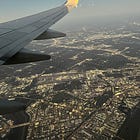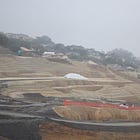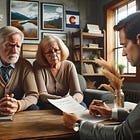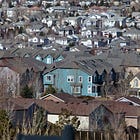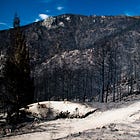The retraction about the Marshall Fire that will never happen.
The Marshall Fire was blamed on climate change within moments of the incident, but all leading variables that made the disaster had nothing to do with the climate.
Posts on The Fleeting West are written and posted quickly and are often edited for clarity and quality later. For the best experience, see the copy on the website for the most up-to-date version. https://fleetingwest.substack.com
A thoughtful heads-up: The following post contains autopsy-style dissections and analysis of the Marshall Fire disaster incident. If you are impacted by this fire or others like it, this post could be distressing and it may be difficult for some readers. My deepest condolences go out to all of the survivors of this disaster and others like it. Please engage with this post at your own discretion and with self-care and -compassion in mind before you begin.
I remember when the Marshall Fire started near Superior and Louisville, Colorado, on December 30th, 2021. I could see it from my front porch, and once I realized the smoke cloud was miles away, I knew it was a big fire.
The color of the smoke indicated it wasn't just another grassland fire and that it must involve industrial materials, like those houses are made of. It was a mix of deep black and dark gray smoke, which isn't the color of a natural grassland fire. It was clearly a big deal. That black smoke was houses, their contents, cars, and businesses.

On that day, it was quite windy, which is entirely normal for the time of year. It can be brutal along the front range in winter with frequent windstorms pressing well into the scales of hurricane-force. Especially in the area of this fire. The Louisville and Superior area is a natural wind-channel as winds slide quickly off the mountains and spill onto the plains without resistance.
On this December 30th, the winds were blowing has hard as a Category 3 hurricane and were bringing in our first notable snowstorm of the early winter, 2021. As usual, the storm was pushing as hard as a dry hurricane, complete with wind gusts of up to 115 mph. Interestingly, the winds on the day of the fire were mild compared to prior record-making windstorms in the area that have pressed into the range of 120-150 mph.
The always unpredictable range of what’s “normal” here is kind of ludicrous and is always left out of the Go West! marketing campaigns.
Contrary to the ensuing news reports, statements from politicians and other ideologues1, the wind event was obnoxiously normal for the time of year. The drought cycle that led us to a dry October through December was also normal, if rare. The combination was even normal, even though not an every-year or even every other year kind of normal.
And, yes, it was warmer and dryer than average, but in a place where the average pretty much never reflects what you’ll actually get, we can only look at how the data points fit into the big range of what normal can be.
But that's not the information we heard at the time of the Marshall Fire, and it's not the information we continue to hear to this day, despite the fact that the data doesn't agree with the mainstream beliefs and ensuing misinformed, runaway narrative2. And it turns out the climate-related data on the climate conditions surrounding the fire have been out for a while and went entirely unnoticed.
Remember when the politicians and media said the Marshall Fire was caused by climate change?
In the days following the Marshall Fire, around the time the snow storm put out the embers, I remember the Mayor of Louisville declared that the fire was ‘caused by climate change.’
When that happened, my whole body and mind slumped in disappointment. She was using the power of the pulpit3 to broadcast a premature position on a scientifically-relevant subject that could further harm the public's understanding and trust in what good science is and how it works.
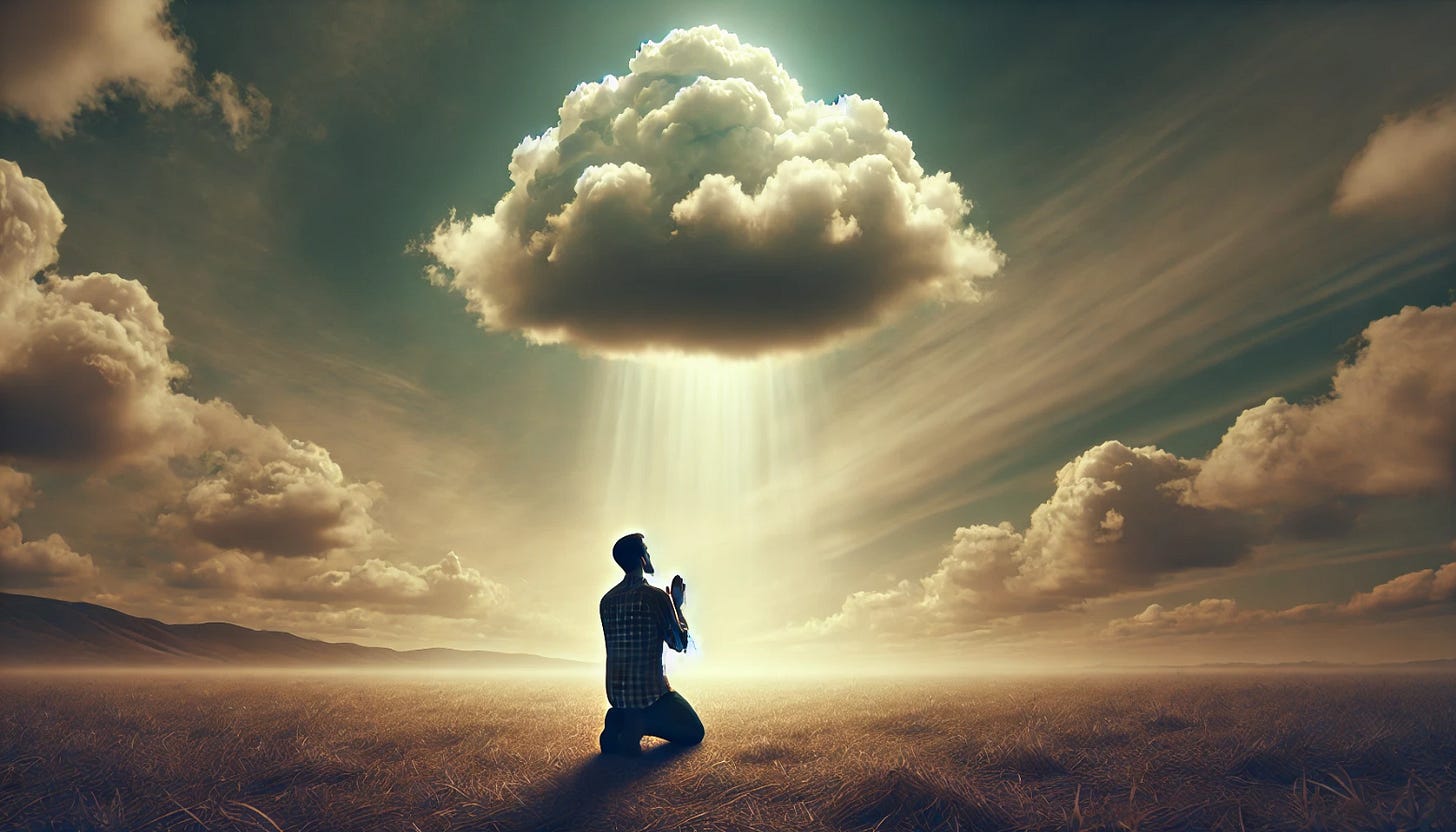
I spent a decade of my life involved in climate research, and then I spent another decade studying and working on disasters. The mayor effectively decided that her voice was more important than those in these fields that are studying these phenomena, how they occur, and what we can do to better position humanity for success in the presence of these disaster-causing, endemic environmental hazards.
The declaration that the fire was caused by climate change demonstrated either a deep misunderstanding of the scientific process, an unintentionally damaging broadcast of a personal opinion from a position of power, or a malevolent stab at spreading misinformation for some other purpose4.
But it wasn't just the Mayor of Louisville who said the fire was caused by climate change. It was media outlets, pundits, other politicians, pseudo-scientists, activist organizations, members of the public, and the comment section mosh-pits of the internet. Groupthink stew.
Even Colorado Public Radio (CPR) got in on the climate action and said, “the impact of climate change was undeniable in the Boulder County fires” on January 10th, 20225, just days after the fire was extinguished.
Many people were saying the incident was caused by climate change — and they believed it to their groupthink-drunken6 cores. Even though the fire origin investigation wasn’t even complete and there was no useful scientific analysis done on the incident yet, the politicians and media declared climate as a cause. Such a fast conclusion is completely counter to anything resembling science, yet many took this position on the issue and rallied around it.
Fascinating that everyone jumped to conclusions entirely without any involvement from scientists or other subject matter experts, especially in hindsight. What was believed to be ‘undeniable’ on January 10th, 2022, now appears to be quite deniable.
The science tells a different story.
The problem with science is that it takes a long time to create reliable and tested conclusions, and even longer to broadcast them. The problem with ideologues and pundits is that it takes no time to create and broadcast uninformed conclusions. The problem with the herd is that they don't listen to the scientists and they take actions on the conclusions of the ideologues and the pundits.
So, it's fitting that while everyone was up in arms about the Marshall Fire being a climate-caused disaster, the first published research on the subject was released years after the smoke cleared without so much as a follow-up or a peep from the pundits, media, and politicians who prematurely declared otherwise.
I don't think there was a single news report on the research referenced that outlines how the conditions leading to the Marshall Fire actually fit the ranges of normal for the environmental conditions in the region, and how the variables that are showing evidence of a changing climate are actually lessening the frequency and intensity of the key variables that drove the fire to become such a big disaster.

If you're thinking that perhaps this scientific research is politically biased or motivated, let's explore that for a moment.
The research I’m referencing and have linked to below was done by scientists at the University of Colorado in Boulder (CU), Colorado State University (CSU), NOAA, and the National Weather Service (NWS). If we want to assign a political stereotype and pop our tinfoil hat on here, the conspiracy-prone should think the research should bias in favor of climate change being the cause, right?
That is to say, if CU Boulder’s researchers are saying the conditions that powered the Marshall Fire fit the range of normal climate conditions, then perhaps we can discard political bias as a motivation here so we can frame a more fact-centered conversation and abandon the harmful politicization of the issue?
And, to be clear, there is obvious bias written throughout the published research, but it’s pretty easy to identify and ends up being relatively minor and harmless in the end. The researchers say this was “a unique event in Colorado,” which is a troublingly partial truth, and they use hyperbole to describe the measured dimensions, calling the wind “dramatic,” which is irrelevant. Their research and other freely available data ends up revealing that the winds, temperatures, and low precipitation weren’t even record-breaking.
The bias in the research is visible when the writers say that the conditions were “exceptionally warm and dry”, then in the same sentence say the records are “near-record mean temperatures and near-record low precipitation.” If it’s exceptional, but doesn’t make or break a record and fits the range of normal, then is it really exceptional? I think this is called grandstanding.
We’ve had drier7 and warmer fall and winter seasons — a lot of them. The records shift by about +/- 8 degrees F from average, and show that it’s more normal to have a year with 6 inches of accumulated precipitation than it is to have a year with 12 inches8 … so, in a place where our sense of normal is extremely abnormal for everyone else, it’s easy to conflate a single data point as being dramatic when it just isn’t.
In a wild turn of events, the area climate conditions that made this fire so damaging may be changing opposite of what our self-appointed disciples of science were squawking about around the time of the fire. It turns out these extreme wind events are decreasing in frequency and intensity in the impacted area9. The winds on the day of the fire weren’t even a high record for the area — it doesn’t even break the top 10 since 1970.
Yep, you read right. One of the most influential weather-related variables that drove the Marshall Fire that we could tie to climate change is actually decreasing in frequency and intensity, and didn’t even set a noteworthy record in this incident.
It’s another example of deep disconnection from the environmental conditions in the interior West.
The majority of people living in the burn area of the Marshall Fire aren't from Colorado. Louisville was one of the first zones around Boulder for those being expropriated from Boulder to go live in as the Rocky Mountain High transplants10 methodically bought them out and displaced them, which went on a tear in the ‘80s and ‘90s.
Then, when Louisville caught on as being an acceptable place to live, the local people were again expropriated from Louisville, being levered out by other exurban trend-followers who came in with bigger money and a thirst for getting in on that Colorado image. Louisville became the place around Boulder for the aspirational elite, while Boulder was annexed by and for the children of established coastal wealth and old money only11. Ask rooted Coloradans if they can afford $750,000 townhomes, $1.1 million 1950s bungalows, or $950,000 starter homes in the Boulder, Louisville, Superior area … the answer is a resounding, nope12.
Superior is a McTracthome bedroom community that popped out of the open plains and coal beds over the last 30-40 years or so and was made entirely possible by the rapid and mass influxes of people from other places. Superior is Louisville’s metastasized twin that popped into existence almost overnight to accommodate the hordes of newcomers with an innate lust for McMansion tract-style living13, just like they had back home, but with that en vogue Colorado image.

All of that to say that the impacted area is almost entirely inhabited by people without any rooted history in the region, and don't have a clue about what the environment here is capable of. They’re clearly getting a taste, but the connections are largely being formed on misinformation14.
When the media, politicians, and transplants all started crying that the wind event was "unprecedented", the aridity was unprecedented, and the burn was unprecedented ... the only thing many of us could do was sit and stare and watch the misinformation disaster unfold.
The powerless response stems directly from having the narrative runaway and be hijacked by those who clearly do not understand a single thing about this place, how long it would take scientists to develop any useful and reliable conclusions about this fire, and the intellectual dangers inherent in declaring opinions before the smoke even clears.
The well-rooted and environmentally acculturated residents know the wind blows really hard along the front range sometimes, especially in the wind-scoured channel between Golden and Boulder. We know it hits hurricane-force on such a regular basis, especially in winter, and any claim that high winds are abnormal is laughably wrong. By the data, we start talking about exceptional or abnormal winds when we exceed about 150 mph in this area15.
We know we can have super dry fall and winter seasons. We know for a fact that we can have banana belt conditions at random throughout our winters. We know that wildfires happen in winter. We know that we can have temperature swings over the course of mere hours or even minutes of over 50-80F, given the right conditions16. We know we can have winters with very little snow, and we can have winters with so much snow that intense flooding in spring is guaranteed. The climate variability here is intense.
The people driving the narrative about the Marshall Fire are all demonstrating their deep disconnection from this place. The climate is volatile AF here in the West, and very few of the newcomers get that because it’s not what they were sold in the marketing and booster campaigns that brought them here expecting an endless Rocky Mountain High vacation experience.

For the locals, this felt a lot like a classic Boulder-area wind storm, which the scientists call a “mountain wave windstorm.” Seems the science and data agree with the locals here — shocking and appalling, I know.
It’s a highly inconvenient truth that none of the climate variables at the time of the fire even broke records or exceeded the ranges of normal for the time of year in the area. The only variables that are exceptional and noteworthy are those related to human behaviors and urbanization in this area, and none of which have any ties to a changing climate.
There's widespread and deep misunderstanding about what kind of fire the Marshall Fire was.
The news media and pundits continue erroneously calling the Marshall Fire a "wildfire." On face, that seems reasonable — it was a fire that seemed wild, right? Some grass caught fire, burned through some trees on Marshall Mesa, then tore through a big open plain of dry grasses and into human-inhabited areas, tearing through homes and businesses in Louisville and Superior.
But does that make it a wildfire?
It’s an indisputable fact that the Marshall Fire was entirely started by humans and human infrastructure. It was started in a suburban and rural area. Then, after burning some structures in rural and unincorporated county spaces, it spilled into an urban-managed open space park area. Then it traveled via highly flammable “fuses” that ran directly up to homes, and started burning homes down, and quickly thanks to the 50-115 mph winds and arid conditions.
In context of fire, fuses are items that help fire travel to something, like a fence, mulch, trees and vegetation — anything combustible that fire can travel along to burn other things and reach structures.
The "open space" that helped carry the fire from its source to other homes and structures is a highly managed park space intended to look “natural.” It’s actually mismanaged, but that's a topic worthy of a whole book, given the mismanagement is directly driven by the premium-paying property owners along it who have strong opinions about how it should be left natural.
The people inhabiting this area regard anything that looks novel and natural as "nature", while many of us from here look at Boulder County's open space and we see mismanaged parks and unnatural buffers for the rich expropriators to maintain their sense of being in the WildColorado™ they were sold in the booster-funded ad campaigns that inspired them to move here. Let’s be clear here — There’s nothing natural or wild about the open space areas in this burn area.
The Marshall Fire is very distinctly an example of "urban conflagration” — which is a fire started by humans and/or urban infrastructure, that stayed in urban-controlled areas, and then burned through suburban neighborhoods and other urban structures17.

There are no “wildlands” near the homes that burned — the open space areas that burned are rural and urban-surrounded and -managed park areas. Talking about the “WUI” (Wildland Urban Interface) in context of the Marshall Fire and others like it is inaccurate because there are no true wildlands in the impact area. The fire never left rural and urbanized spaces, including the open space park area it ran through to reach the dense suburban areas, which turned the fire into a disaster.
Note that disasters only occur in the human-domestic space. A fire that burns through grasslands is a natural process and is never recognized as a disaster, yet when that same fire burns down hundreds of homes, it becomes a disaster.
If you're still talking about the Marshall Fire being a "wildfire", it’s incorrect. It’s like calling a Pepsi a Coke, a creek a river, or calling shoplifting burglary. The difference might seem nuanced, but it’s substantial.
The narrative on the subject is being controlled and distorted by numerous people who don't understand this incident. They don't understand the science. They don't understand the context. They don't understand this environment. They don’t understand the dimensions that made this disaster possible. They don’t understand the history of this area and its open spaces and developments.
And they definitely misunderstand the fundamental dynamics of where they've moved to, their role in making disasters like this possible, or how their use of climate change as a scapegoat for what's really happening is a primary the root of the problem and a primary barrier to preventing future disasters and human impacts like it.
When we boil down the variables that drove the Marshall Fire, it’s clear that saying it was “caused by climate change” is misinformation.
Don't get me wrong, the Marshall Fire was a —big— disaster. It left so many people with deep scars that will never heal. But the next layer of injustice is to misunderstand, misconceive, and misinform about the multiple leading variables involved in the incident.
The Marshall Fire disaster was caused by a fire that was started by humans, human infrastructure, in a relatively recently urbanized space. The fire was carried by high winds that were not only normal, but by the data, weren’t even record-worthy for the area and time of year. If it weren’t for the fire, the winds on that day would be nothing more than a minor record on an obscure page on the internet, and none of us would even have a flashbulb memory18 as a result of it.
The fire was carried through human-controlled terrain, human mismanaged open spaces, and along human-placed fuses to homes and other domestic structures. The temperatures and climate conditions for the area all fell in the range of normal for the region, in both range, period, and frequency … except for the intensity and frequency of the windstorm itself, which was less intense than it could have been and didn’t break any records.
Nothing about the climate conditions in the months leading up to December 30th, 2021 were outside of the range of what's possible for this area. The fire could have been made worse by the aridity, but this is a highly arid area, and the aridity fit the ranges of the normal cycles for the local area and broader region.
One truly abnormal dimension that directly fueled the Marshall Fire is the long-term, extreme disruption to the endemic fire regime, resulting in extreme fuel loads for the fire to consume19. Disrupting the fire regime resulted in the unprecedented fuel loads on the land that helped amplify and carry the burn20.

The optimal natural fire return interval for this environment is 0-5 years, which means that a fire in a plains ecosystem could happen more than once in a year, and after about five years, you start to see abnormal, unnatural, and unlikely levels of fuel loading. Fuel loading simply means the amount of fuels present for a fire to consume. Think dry grasses, trees, and other combustible detritus.
The open space in this area was prevented from burning to “protect” homes for something like 60 years or more, putting the faux-natural plains biome on the open space area so far outside of its fire regime that fuels were many times what they would have been under truly natural conditions.
The other abnormal dimension that helped the fire to become a disaster is the direct interface between open space and the urban environment. A fire-dependent ecosystem that was being mismanaged backs directly up to houses in this area. A leading variable of the disaster, right there.
In the list of the most dominant variables that caused the Marshall Fire, none of the leading variables point to climate conditions outside of the range of normal for the area. None.
Might a changing climate have amplified some elements of the fire behaviors? Probably — but this fire would have happened with our without a changing climate in this area because of all of the vastly more dominant direct causes of this fire that all center on other human-caused actions and behaviors.
All of the variables that allowed the fire to spread to human structures and to become a disaster are all related to extreme disruption of endemic ecosystem processes, and the purely insane direct interface between homes and the fire-dependent ecosystem that have been curated purely for decorative purposes by a group of people who are deeply disconnected from the place they have chosen to forcibly insert themselves as residents.
Check your misinformation, get your facts straight.
There's a lot to unpack here, so let's summarize:
The science on the climate conditions that led the Marshall Fire to become a disaster do not support changed-climate variables as being leading variables that caused or allowed this fire to become a disaster in the human-domestic space.
The climate conditions preceding, during, and after the fire all happen to fit the range of "normal" for the region and the long-term climate trends for the area, except for the decreased frequency and intensity of wind events, including the one that helped this fire run so quickly and damagingly.
The way so many people understand the Marshall Fire to be a wildfire is entirely incorrect. It's not even close to right. The Marshall Fire was an urban conflagration incident, not a wildfire. The fire didn’t start in a wild space, it was not ignited by natural causes, and it stayed within entirely human-controlled spaces for its entire run.
The environment-controlled variables that assisted the destructiveness of the fire include wind speed, air temperature, micro-climate trends in the area, such as precipitation, humidity, and high and low temperatures over time — all of which fit the range of normal for the impacted area. Yes, we were in a seasonal drought, but that drought also fit the range of normal for the area, so the tie to a changing climate isn’t strong enough to conflate it as a leading variable, or as a “cause”.
Let’s be super clear about the direct cause of the two fires that merged and became The Marshall Fire here as the top leading variable: People burning trash during high winds (seriously), and a downed power line by high winds21. Human … Caused … People lit the place on fire during a dry windstorm during a drought year.
The next-layer leading variables that made the disaster possible were the shape of the built environment that included zero defensible space for calm fire conditions and absolutely zero during high wind conditions. And the fuses that led fire directly to homes, the open-space-urban-interface (the “OSUI”, let’s call it)22 that put a curated false-wildland directly up against homes and urban infrastructure, which also happened to be entirely and still fire-dependent.
More leading variables include the total disregard for hardening homes and structures to be fire resistant in this entirely fire-dependent, -prone, and arid environment that is uniformly present in the burn area. Just a bunch of trash eastern-American style, toothpick-built tinderboxes, placed right up against a fire-loving slice of investment-quality open space heaven. What could go wrong?
Another leading variable: Extreme fire suppression that has taken place on the open space areas over the last 50+ years to support urban development, which left unprecedented fuel loads on the ground for the fire to burn given the fire-dependent nature of the biome in this place — This is an extremely dominant leading variable in this disaster. The fire return interval of the false wildland area was far out of its natural cycle by a factor of 10-20x or more of normal.
The narrative about the Marshall Fire is dominated by misinformation super-spreaders, the scientifically illiterate, environmentally disconnected transplants, and those driven by internet echo-chambers, groupthink, and mob-mentality.
The disaster was made possible by a high wind event that fit the range of normal for the region, with aridity that fit the range of normal, and during a time of year when all of these variables can align to create regularly dry, balmy, and high-wind conditions that are perfect for fires. Add a man-made slag pile fire going out of control, and whoosh! Check, check, and check!
Even wilder, if this same fire had broken out in 1970 instead of 2021, it would have burned only a couple human-built structures and not even made national news, because there weren’t enough structures in the way for it to become any kind of disaster. It would have just been a normal grassland fire that burned down a couple farmhouses. When some grass burns in the West, does it make the news?
None of this is to say there weren’t variables being modified by a changing climate, but in the first reasonable science we’ve seen on the subject, it appears that all of the climate-related variables fit into the range of normal for the region, while the human behaviors in the area are the variables that made this disaster so big and so destructive in the domestic space.
The leading variables in this incident steamroll and dwarf the climate variables so substantially that any mention of climate change when talking about the Marshall Fire is an immediate indication of the presence of deep misinformation and misunderstanding of this disaster.
In all, the distortion of information regarding the Marshall Fire is the norm, not the exception.
Most of the people on the climate change misinformation train aren’t interested in facts about the environment of the interior West; they’re interested in coddling their own dissonance between what they were sold and what they’re actually experiencing here.

The fastest injection of relevant information is that the Marshall Fire wasn't a wildfire, it was urban conflagration. The climate conditions before and during the event all fit the range and frequency of normal for the region, with a notable downtrend in frequency and intensity, as the research suggests. The shape of the urban environment and how we orient homes and human infrastructure in these high-hazard, high-danger-level hazard23 environments is the leading cause that allowed this fire to become an extremely expensive disaster in the domestic space. Climate change doesn’t even make the scoreboard when we look at the causes of this disaster. Causes, plural.
The causes of the Marshall Fire.
The fire was directly ignited —caused— by people and wind-damaged power infrastructure. A normal scale and intensity windstorm for the area caused the fire to run and spread quickly. The artificially high fuel loads on the open space landscape as a result of extreme fire suppression over decades to protect human-built structures without any fuel reduction efforts caused the fire to gain energy and the capability to burn down homes and other human structures. The total lack of defensible space between homes and park open space caused the fire to enter the human domestic space and to be so incredibly destructive so quickly. The houses being built just feet from each other caused the fire to easily jump from home to home so quickly. The total disregard for fire as a threat in this entirely fire-dependent environment caused the fire to easily reach homes by following resident- and builder-placed flammable materials that acted as fuses. The total lack of fire-hardening in home construction and design caused the homes to burn so easily and completely.
All of the leading causes of the Marshall Fire were human behaviors and decisions around the human-built environment and a deep lack of understanding of where they live and how this place works. When all of the climate variables fit the observed ranges that are normal for the area, we have to throw in the towel and admit that any causal relationship with climate-amplified dimensions of the disaster are marginal and overshadowed to the point of obscurity in the face of the indisputably dominant leading and causal variables.
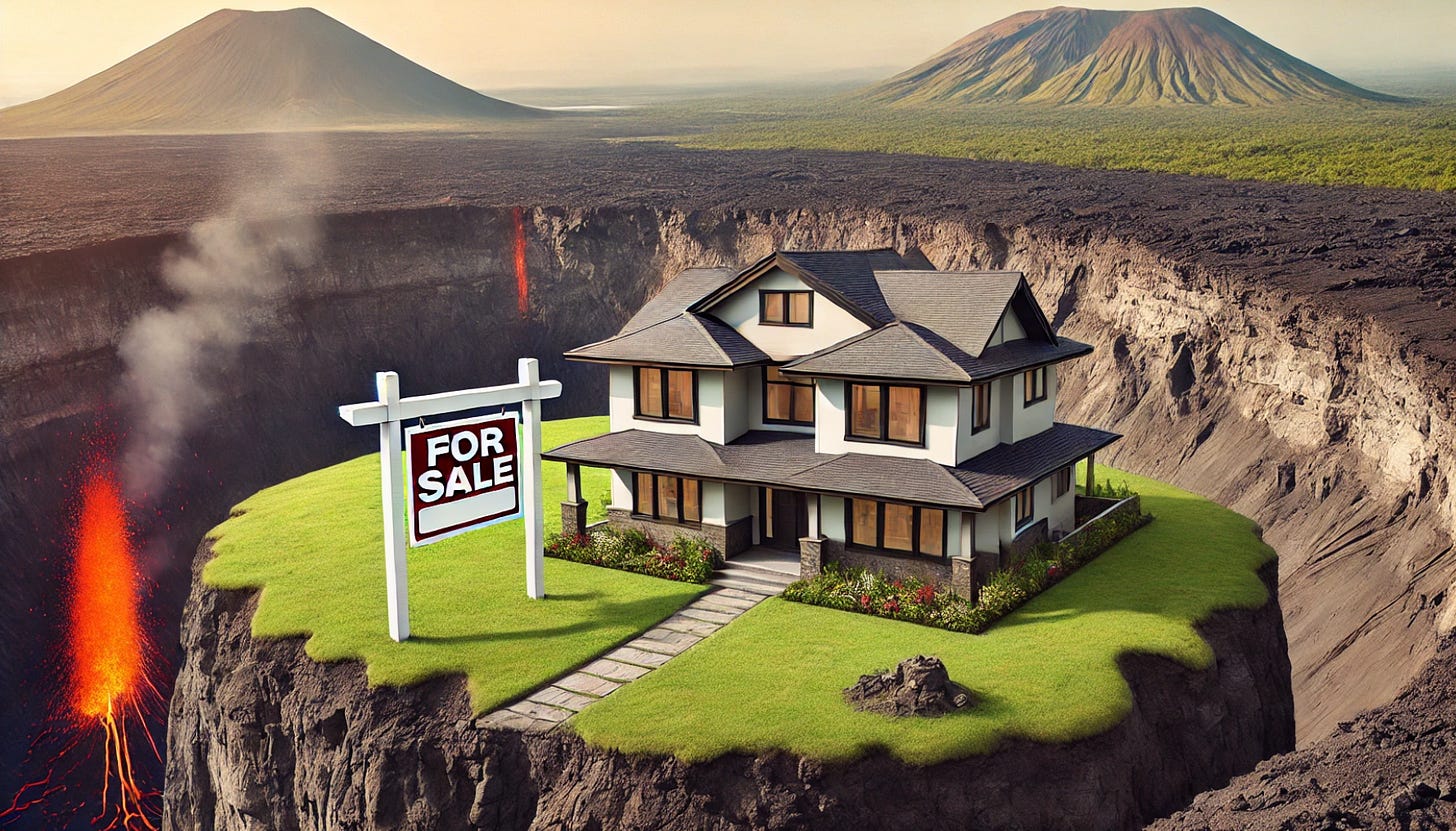
The Marshall Fire disaster was caused and made worse entirely by people. The variables driven by climate change are so small in comparison to the multiple and dominant leading variables that it’s irrelevant to even mention climate change in context of this disaster. It’s clear that those declaring the fire as caused by climate change are preaching from the pulpit with faulty information. Let’s stop mistaking and conflating the negligible variables as the leading variables so we can constructively move forward in preventing disasters like this from happening in the future.
Go take a look at the data for yourself:
NOAA Communications. "Looking Back at Colorado's Marshall Fire." NOAA. 9 Jan 2024.
🔗 https://research.noaa.gov/looking-back-at-colorados-marshall-fire/
NOAA Physical Sciences Laboratory (PSL). “Boulder Monthly Climate Data: Precipitation.” National Oceanic and Atmospheric Administration (NOAA). Accessed, 2 March 2025.
🔗 https://psl.noaa.gov/boulder/Boulder.mm.precip.html
NOAA Physical Sciences Laboratory (PSL). “Boulder wind info.” National Oceanic and Atmospheric Administration (NOAA). Accessed, 2 March 2025.
🔗 https://psl.noaa.gov/boulder/wind.html
Stanley G. Benjamin, E.P. James, E.J. Szoke, P.T. Schaltter, and J.M. Brown. "The 30 December 2021 Colorado Front Range Windstorm and Marshall Fire: Evolution of Surface and 3D Structure, NWP Guidance, NWS Forecasts, and Decision Support." American Meterological Society (AMS), 12 Dec 2023.
🔗 https://journals.ametsoc.org/view/journals/wefo/38/12/WAF-D-23-0086.1.xml
The Fleeting West is written by a rooted Westerner with decades of study in environmental sciences, disasters, and most importantly, generations of acculturation to this place and its endemic climatic volatility.
Footnotes and Citations
Ideologues - those who are blindly partisan advocates or adherents of a particular ideology (Credit: merriam-webster.com)
More about wildfire misinformation in this old and supporting post:
I use “Power of the Pulpit” here as somewhat of a metaphor — It’s typically used in context of religion and preaching. In this case, the statement was issued from a position of power, being heard, and preaching on an opinion and statement of faith, without involvement from the “people” or the “experts” that may have taken a different approach.
The local and state governments of the West have been overthrown by non-local people with no understanding of what this place is, how it works, and what’s normal. More about that here:
Here’s the story, it’s still up:
https://www.cpr.org/2022/01/10/boulder-county-marshall-fire-climate-change-firefighting-land-management/
Groupthink - a mode of thinking where a group mistakes their unanimity for being right, and they work harder on the unanimity than establishing defensible facts. Apparently defined by Irving Janis (more at: https://sma.nasa.gov/news/sma-news-archive/watch-out-for-groupthink)
Think we haven’t had many drier years? Take a look at the data …
https://psl.noaa.gov/boulder/Boulder.mm.precip.html
I’m referencing other data here — this time, from weather.gov, and a scatterplot they released of temperature v. accumulated annual precipitation. Note that the graph I’m referencing has a total scale of 10 degrees F, and a total scale of ~24 inches of accumulated precipitation. It took me a minute to figure out that the graph could lead to erroneous conclusions, too, because it could lead to an impression of 2021 being “exceptional” … but it wasn’t. It was less exceptional than 2013, 2009, and was within a hair of 1980, 1981, and so on. Link: https://www.weather.gov/bou/HighWinds12_30_2021
Check out NOAA’s wind event records, freely available on their website — the trend is visible to the naked, unskilled eye:
https://psl.noaa.gov/boulder/wind.html
"Rocky Mountain High transplants” — I’ll write about this more later, but these are the people who flooded into the state in the time around John “Denver” Deutschendorf’s rise to fame with release of his transplant anthems in the early/mid 1970s. More to come on that.
As it turns out, the righteous arrow of progress always points to “YES!” and never to “no” when it comes to development in the West and accommodating the millions of exurban transplants who think they want to live in the most climatically, hazard-prone places on the continent. More about that here …
More about the cause and effect of the ludicrous housing cost increases we’ve endured in Colorado, here:
More about the displacement of local people in this prior post about how the local people are being economically levered out of their home areas by trend-followers from across the country:
Where your mind formed is where you established your understanding of how the world around you works — and when that’s hundreds or thousands of miles away from this wondrous new place you’ve moved to, you might have some huge blind-spots for interpreting hazards and disaster events. More about that in this old post:
Again, the wind records for the burn area don’t even make it into the top 10: https://psl.noaa.gov/boulder/wind.html
More about transplant reactions to the volatile climate here in this older post — interesting, if a little reactionary to the uncontrollable idiosphere.
Urban conflagration is sometimes called, “Town and City Fires,” Wikipedia has a great list of prior events like it on their page, and the curators were even smart enough to include the Marshall Fire in this list:
https://en.wikipedia.org/wiki/List_of_town_and_city_fires
Flashbulb Memory - When an event causes you to remember something clearly and the conditions surrounding it, like a disaster. If not for the fire that became the Marshall Fire, no one would remember December 30th, 2021 for any reason related to the wind storm.
Another supporting post to this one, more about our fire-dependent environment here:
More about the effects of fire suppression on fuel loading as a result of development in this prior post:
NIST calls the areas that burned something like “Types 1-7 WUIs” — Lots of hair-splitting that I find to be lacking vital nuance, but worth a citation here:
https://www.nist.gov/el/fire-research-division-73300/wildland-urban-interface-fire-73305/hazard-mitigation-methodology-9
Boulder County released a report on the investigation of the cause of the fire, which can be seen freely here:
https://assets.bouldercounty.gov/wp-content/uploads/2023/06/marshall-fire-investigative-summary.pdf
The differentiation of “high-danger hazards” is important because these aren’t just high winds with water droplets. We’re talking about high winds mixed with burning material, fire, and smoke that can hit hundreds of degrees. Not all hazards have the same level of danger for life safety.







